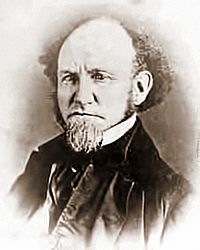Charles Whittlesey (geologist) facts for kids
Charles Whittlesey (born in Southington, Connecticut, on October 4, 1808; died in Cleveland, Ohio, on October 18, 1886) was an amazing person who was a soldier, a geologist (someone who studies Earth's rocks and history), and a researcher of ancient Native American mounds. He was known as a "zealous investigator" in the study of ancient American sites.
Quick facts for kids
Charles Whittlesey
|
|
|---|---|
 |
|
| Born | October 4, 1808 Southington, Connecticut |
| Died | October 18, 1886 (aged 78) Cleveland, Ohio |
| Allegiance | United States of America Union |
| Service/ |
United States Army Union Army |
| Years of service | 1831-1832 (U.S. Army) 1861–1862 (Volunteer Army) |
| Rank | |
| Unit | 20th Ohio Infantry |
| Commands held | 3rd Brigade, 3rd Division, Army of the Tennessee |
| Battles/wars | American Civil War |
| Other work | geologist |
| Signature | |
Contents
Early Life and Studies
Charles Whittlesey started his journey at the United States Military Academy in 1831. After graduating, he joined the U.S. Army's Fifth Infantry regiment. In 1832, he was stationed at Fort Howard, Wisconsin. He even served briefly in the Black Hawk War.
However, he decided to leave the army later that year. He then studied law and became a lawyer in Cleveland. From 1836 to 1837, he also worked as an editor for the Cleveland Herald newspaper.
Exploring Ohio's Land
In 1837, Whittlesey became an assistant geologist for the State of Ohio. His job was to map the land and study its features. He helped discover the rich coal and iron deposits in eastern Ohio. These discoveries were very important for the state's future industries.
During this time, he also carefully studied and measured many ancient earthworks. These were built by the Mound Builders, who were early Native American people. His detailed maps and notes of twenty of these sites were included in a famous book called Ancient Monuments of the Mississippi Valley.
Discoveries in the Great Lakes Region
From 1847 to 1851, the U.S. Government hired Whittlesey. He conducted a mineral and geological survey around Lake Superior and the upper Mississippi River. This work helped us understand the natural resources of these areas.
After this, he worked as a mining engineer in Michigan, Wisconsin, and Minnesota. In 1858, he joined the geological survey of Wisconsin.
Service in the Civil War
In February 1861, Charles Whittlesey joined a group that helped escort President-elect Abraham Lincoln to Washington. When the American Civil War began, he quickly offered his skills.
On April 17, 1861, he became an assistant quartermaster general for the Governor of Ohio. He served as the chief engineer for Ohio troops during the Western Virginia Campaign. After his initial service, he was appointed colonel of the 20th Ohio Infantry on August 15, 1861. He was also the chief engineer for the Department of the Ohio. In this role, he helped plan and build the defenses of Cincinnati.
Whittlesey fought in important battles like the Battle of Fort Donelson, where he led his regiment. After this battle, he was in charge of over 10,000 captured Confederate soldiers. He also commanded a brigade at the Battle of Shiloh. However, his health declined, and he had to leave active service in April 1862. He returned briefly in September 1862 to help with Cincinnati's defenses again. After the threat passed, he went back to civilian life.
Later Life and Legacy
After the war, Whittlesey continued his geological explorations around Lake Superior and the upper Mississippi River. He also kept up his writing. In 1867, he helped start the Western Reserve and Northern Ohio Historical Society. He was its president until he passed away in 1886. In 1870, he became a member of the American Antiquarian Society.
Because of his important work describing early Native American people, an archaeological group of people was named after him. The Whittlesey culture describes people who lived in Northeast Ohio from about A.D. 1000 to 1600.
Published Works
Charles Whittlesey wrote about 200 different reports and books. Besides his geological survey reports, he published several important works:
- Historical collections of Ohio : containing a collection of the most interesting facts, traditions, biographical sketches, anecdotes, etc. (1848)
- Descriptions of Ancient Works in Ohio (Washington, 1851)
- On Fluctuations of Level in the North American Lakes (1860)
- Ancient Mining on the Shores of Lake Superior (1863)
- On the Fresh-Water Glacial Drift in the Northwestern States (1866)
He also wrote:
- Life of John Fitch, in Sparks's “American Biography” (Boston, 1845)
- Early History of Cleveland and Vicinity (Cleveland, 1867)

